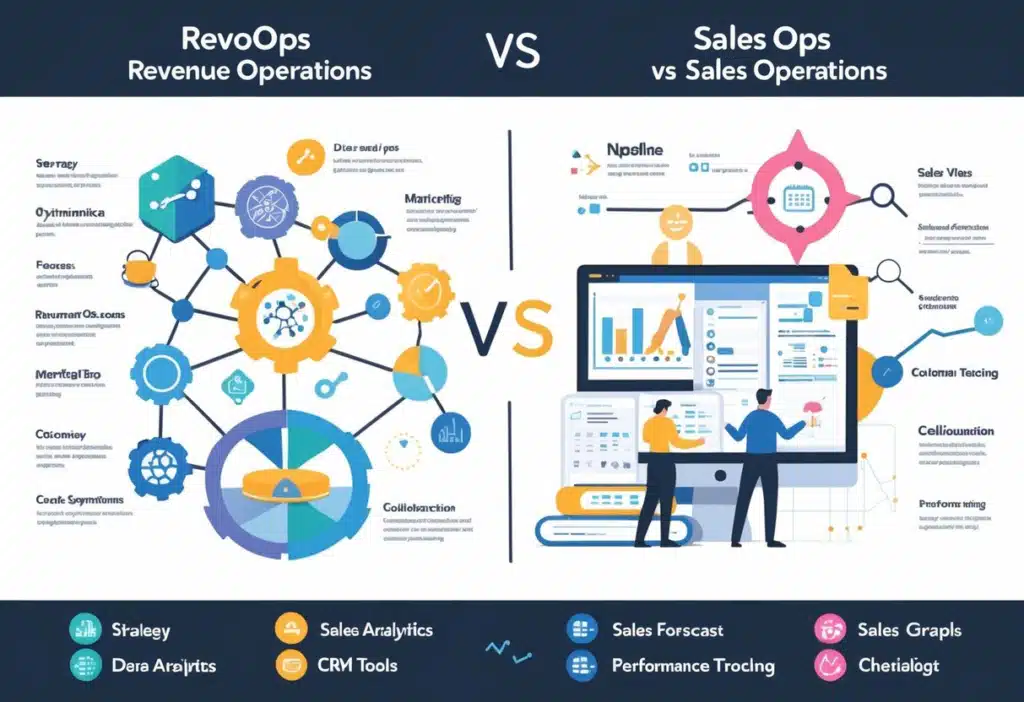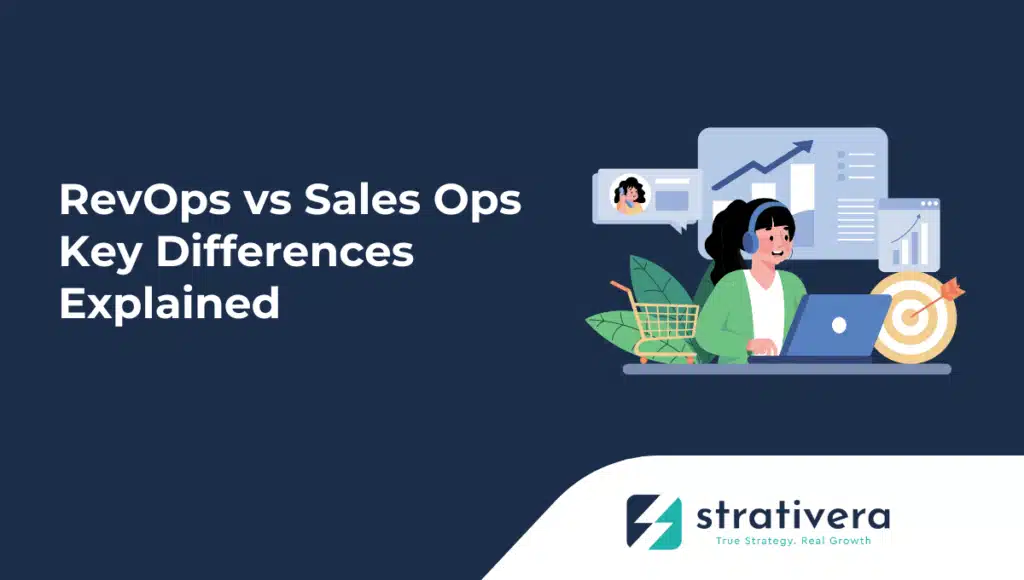Table of Contents
Modern businesses face a tough decision when structuring their revenue-generating operations: should they go with Revenue Operations (RevOps) or stick to the traditional Sales Operations (SalesOps)? Both aim to drive growth, but they take pretty different routes—especially in scope, methods, and how they affect the organization.

RevOps takes a holistic approach by aligning sales, marketing, and customer success teams under a unified strategy. SalesOps, on the other hand, focuses on optimizing sales team performance and processes.
This core difference shapes everything—from how teams are set up and which tools they use, to what metrics they track and how customers experience the business.
As companies grow, understanding these frameworks becomes pretty important. Picking between RevOps and SalesOps—or figuring out how they can work together—depends on company size, maturity, and the specific challenges on the table.
Defining RevOps and Sales Ops

Revenue operations aligns sales, marketing, and customer success under one operational strategy. Sales operations, meanwhile, zeroes in on making sales teams as productive and effective as possible.
What Is RevOps?
Revenue operations acts as a strategic framework that unifies sales, marketing, and customer success under a single approach. RevOps professionals work hard to break down the silos that tend to keep these teams separate.
The main goal? Create seamless collaboration across all revenue-generating functions. Teams share data, insights, and strategies to optimize the customer journey from first contact to long-term retention.
Core RevOps functions include:
- Cross-departmental team integration and alignment
- Unified data management and analytics
- Customer experience optimization throughout the lifecycle
- Revenue forecasting across all touchpoints
RevOps teams measure success using broader metrics like annual recurring revenue (ARR), customer lifetime value, and revenue retention rates. These numbers cover multiple departments, not just one.
RevOps works best for established companies with mature departments that have trouble coordinating. Organizations usually turn to RevOps when their data feels scattered, goals are fuzzy, or teams just aren’t communicating well.
What Is Sales Ops?
Sales operations concentrates exclusively on improving sales team efficiency and effectiveness. Their job is to help sales reps spend more time selling and less time bogged down by admin work.
Sales ops folks refine internal sales processes, set up sales-specific tools, and analyze sales data. They hunt down bottlenecks in the sales funnel and come up with ways to move deals along faster.
Key sales ops responsibilities:
- Sales process optimization and standardization
- CRM management and sales tool implementation
- Sales performance analysis and reporting
- Territory planning and quota setting
- Sales training and enablement programs
They track metrics like close rates, average deal size, sales cycle length, and pipeline velocity. These numbers tie directly to how well the sales team performs and how quickly revenue comes in.
Sales ops fits best for smaller organizations or companies with pretty straightforward sales processes. If the main revenue headaches come from sales inefficiencies (and not bigger organizational issues), sales ops is usually the answer.
Why the Distinction Matters
Understanding the difference between these two helps organizations figure out which operational strategy fits their needs and growth goals. Plenty of companies waste time and money implementing the wrong model.
The choice depends on business size, organizational maturity, and specific revenue challenges. Smaller businesses usually get more out of sales ops, while bigger, more complex organizations need RevOps to tie everything together.
Revenue operations solves complex, cross-team coordination problems. Sales operations fixes issues that are specific to the sales department through targeted improvements.
If you’re seeing gaps between marketing, sales, and customer success, RevOps might be the move. If the issues live only in sales, dedicated sales ops makes more sense.
Decision factors include:
- Company size and departmental structure
- Complexity of sales processes
- Where revenue leaks are happening (departmental or cross-functional)
- Resources available for implementation
- Long-term growth goals
This distinction matters when it comes time to allocate budget, hire people, and build strategies that actually move the revenue needle.
Core Responsibilities and Functions

Revenue operations aligns multiple departments to optimize the whole revenue engine. Sales operations, meanwhile, digs into enhancing sales team productivity and performance.
Each manages different processes that support specific parts of revenue generation.
RevOps: Organization-Wide Alignment
RevOps teams align sales, marketing, and customer success under one revenue strategy. They break down silos so customers have a seamless experience throughout their journey.
Key alignment activities include:
- Standardizing data collection across all revenue teams
- Creating unified dashboards for pipeline visibility
- Establishing consistent lead scoring and handoff processes
- Implementing shared KPIs that encourage collaboration
RevOps manages the tech stack for multiple departments. They make sure CRM, marketing automation, customer success platforms, and sales tools all play nicely together.
They develop cross-functional processes to drive revenue growth. For example, they spot where leads get stuck between marketing and sales, and they track customer health to prevent churn or find upsell chances.
RevOps also runs enablement programs that span departments. This might include onboarding for new hires across teams or training modules to help sales and customer success work better together.
Sales Ops: Supporting Sales Performance
Sales operations teams focus only on making the sales team more efficient and effective. They handle the tactical stuff that lets sales reps spend more time actually selling.
Primary support functions include:
- Territory planning and quota allocation
- Managing sales compensation plans
- Optimizing lead routing and assignment
- Setting up and maintaining sales tools
Sales ops analyzes sales data to spot performance gaps and opportunities. They track things like conversion rates at each pipeline stage and average deal size by territory.
The team manages enablement just for sales. They put together battle cards, competitive reports, and objection-handling guides. Training on new products or sales methods also falls to them.
Sales ops keeps the sales process running smoothly. They update CRM workflows, create automated follow-ups, and define pipeline stages so reps know what’s expected.
Key Processes Handled by Each
RevOps manages enterprise-wide processes:
- Optimizing the entire customer lifecycle, from lead to renewal
- Revenue forecasting across all departments
- Cross-team reporting and analytics
- Technology integration and data governance
Sales Ops handles sales-specific processes:
- Pipeline management and deal tracking
- Sales territory optimization and capacity planning
- Commission calculations and incentive programs
- Sales tool training and user adoption monitoring
This split lets each team specialize, while still keeping the organization moving in the right direction. RevOps provides big-picture oversight, and sales ops delivers tactical support that hits sales performance goals.
Organizational Scope and Structure
RevOps covers the entire revenue-generating ecosystem. Sales ops, though, zooms in on sales team optimization. The way these are structured really changes how teams work together and who they report to.
RevOps Across the Revenue Stream
RevOps runs as a cross-functional system that aligns sales, marketing, and customer success into one revenue engine. This setup breaks down the usual departmental walls to create unified processes for the whole customer lifecycle.
They cover everything from the first marketing touch to customer retention and expansion. RevOps coordinates marketing campaigns, sales processes, onboarding, and ongoing customer success efforts.
Key organizational characteristics include:
- Centralized reporting to a Head of RevOps
- Shared metrics across all revenue teams
- Integrated tech stack serving multiple functions
- Standardized processes across departments
By 2026, 75% of high-growth organizations are expected to adopt a RevOps model. This structure helps manage the customer experience by keeping interactions consistent from start to finish.
Finance teams get more accurate forecasts when RevOps pulls together unified revenue data. Customer engagement strategies also get a boost, since marketing, sales, and customer success all work from the same playbook.
Sales Ops in the Sales Department
Sales ops works within the sales organization as a specialized support crew focused on performance and efficiency. They usually report straight to sales leadership and don’t stretch across departments.
Their scope covers sales process optimization, territory management, and enablement activities. Sales ops wants to cut admin work for reps and speed up deals in the pipeline.
Primary structural elements include:
- Reporting directly to the VP of Sales or CRO
- Department-specific tools and processes
- Sales-focused metrics and KPIs
- Territory and quota management
Sales operations professionals typically earn $70,000 to $120,000 annually, with senior roles going above $150,000. This focus lets them develop deep expertise in sales processes.
Sales ops emphasizes productivity through targeted training, playbooks, and performance tracking. Their involvement with the customer lifecycle mostly stops after the sale, with limited post-sale activity.
Customer satisfaction efforts here focus on the buying experience, not ongoing engagement or retention.
Key Differences: RevOps vs Sales Ops
Both aim to boost revenue, but they play at different levels. RevOps looks at the big picture across departments, while sales ops drills down into sales team performance and processes.
Scope and Focus
Revenue operations brings together sales, marketing, and customer success teams to build unified strategies for the whole customer lifecycle. This cross-team approach makes sure everyone’s working toward the same goals.
RevOps pros dig into data from every touchpoint to spot bottlenecks and opportunities. They connect marketing automation, CRM, and customer success tools to keep everything in sync.
Sales operations sticks to sales-specific practices and tools that make the sales team more effective. That means optimizing the sales tech stack, streamlining processes, and boosting rep productivity.
SalesOps teams handle things like territory management, quota setting, and pipeline optimization. They work inside the sales department to clear out friction and smooth the selling process.
Data and Process Integration
RevOps pulls together marketing automation, CRM systems, and customer success platforms into one data ecosystem. This setup lets everyone see customer interactions across all departments.
They standardize processes between teams and set up consistent metrics for tracking performance. RevOps teams roll out shared dashboards to monitor how customers move through different stages.
Sales operations zeroes in on making the sales function itself run smoother. They configure CRM systems for sales workflows and add automation tools tailored for sales.
SalesOps teams work on lead routing, managing opportunities, and improving forecasting. They make sure sales reps have clean data and efficient workflows inside their own sales tech stack.
Impact on Revenue Growth
Revenue operations boosts growth by getting departments aligned and improving the customer experience. Companies using RevOps usually see less deal slippage and better forecasting because they get a clearer view of the whole revenue cycle.
This approach closes revenue leaks between departments and makes handoffs smoother along the customer journey.
Sales operations helps revenue by making sales teams more productive and efficient. Organizations often notice faster deal cycles, higher conversion rates, and better sales rep output.
SalesOps efforts bring in more qualified leads and help teams stick to the sales process. The focus on sales allows for quick changes that improve results.
Tech Stack, Tools, and Analytics
The tools each team uses really show what they care about. Sales ops teams spend most of their time on CRM optimization and sales-focused platforms, while RevOps manages systems that tie together several departments.
CRM and Data Management
Sales ops teams mostly handle CRM optimization for the sales org. They set up Salesforce or HubSpot for sales needs, managing lead routing, opportunity stages, and pipeline visibility.
They track sales metrics like conversion rates, deal speed, and quota attainment. Sales ops keeps sales data accurate and contact records clean for the reps.
RevOps goes bigger, handling CRM and data integration across teams. They connect marketing automation, customer success tools, and sales systems to build unified customer profiles.
RevOps teams set up data governance policies for all departments. They make sure marketing qualified leads reach sales smoothly, and customer success data shapes renewal strategies.
Key CRM Focus Areas:
| Sales Ops | RevOps |
|---|---|
| Sales pipeline stages | End-to-end customer journey |
| Lead assignment rules | Cross-team data integration |
| Sales forecasting accuracy | Unified reporting dashboards |
Sales Enablement Tools
Sales ops manages tools that support reps day-to-day. They roll out sales enablement platforms, set up email sequences, and keep sales content libraries organized.
Common tools include Outreach for sequences, deal desk software for pricing, and sales training platforms. Sales ops makes sure these tools connect to the main CRM.
They pay attention to sales productivity metrics like email open rates, call connection rates, and how often reps use content. Sales ops watches which resources actually help reps hit targets.
RevOps takes enablement further by including marketing and customer success tools. They keep messaging consistent across every customer touchpoint and standardize account handoffs.
RevOps teams look at how enablement tools affect the whole revenue funnel, not just sales conversion.
Forecasting and Reporting
Sales ops builds sales forecasting models using past sales data and current pipeline health. They create reports on rep performance, territory analysis, and quota tracking.
Their forecasts focus on quarterly and yearly sales goals. Sales ops studies how deals move through the pipeline and spots risks to hitting targets.
They build dashboards for key metrics like average deal size, sales cycle length, and win rates by product or market.
RevOps builds revenue forecasting that includes marketing leads, sales conversion, and customer expansion. Their reports cover multiple departments and longer timeframes.
RevOps forecasts track customer lifetime value, churn predictions, and expansion revenue. They connect marketing campaigns to pipeline quality and see how customer success affects renewals.
Reporting Scope Comparison:
- Sales Ops: Sales performance, pipeline management, quota tracking
- RevOps: Revenue attribution, customer journey analytics, cross-team metrics
Impact on the Customer and Business Outcomes
RevOps and SalesOps both shape customer relationships and business results. RevOps improves the whole customer experience, while SalesOps focuses on making the sales process smoother.
Customer Experience and Lifecycle
RevOps changes the customer experience by connecting every touchpoint. Customers get consistent messaging from marketing, sales, and support throughout their journey.
Companies that use RevOps see a better customer experience because teams work toward the same customer goals. This teamwork cuts down on friction when departments act separately.
Customer Journey Optimization:
- Smoother handoffs between departments
- Consistent data across all customer interactions
- Faster responses to customer questions
- Personalized experiences using the full customer history
SalesOps zooms in on the sales part of the customer journey. Sales teams with better tools and processes can give buyers a more efficient experience.
This helps during the sales phase, but it doesn’t always fix issues in marketing or after the sale. Support and success teams usually run their own show here.
Driving Sustainable Revenue Growth
RevOps builds sustainable growth by optimizing several revenue streams at once. They track metrics like customer lifetime value, annual recurring revenue, and retention rates across all teams.
RevOps breaks down silos between departments so teams can spot new revenue opportunities and stop leaks. Everyone works together to get the most value from each customer.
Revenue Impact Areas:
- Customer Lifetime Value: Boosted by coordinated retention efforts
- Churn Reduction: Teams spot at-risk customers early
- Expansion Revenue: More cross-sell and upsell chances
- Customer Acquisition Cost (CAC): Lowered by aligning marketing and sales
SalesOps pushes revenue growth by making sales teams more effective. The focus is on closing deals faster and raising average deal size.
Sales teams see better conversion rates and shorter cycles. But, boosting customer lifetime value and long-term retention really depends on working with other teams.
Optimizing Conversion and Retention
RevOps works on conversion rates across the whole customer lifecycle, from first lead to renewal and expansion. Teams share insights to improve at every step.
They can spot conversion problems that cross departments. Marketing, sales, and customer success join forces to fix these issues.
Key Conversion Metrics:
- Lead-to-customer conversion rates
- Trial-to-paid conversion rates
- Customer renewal rates
- Expansion revenue conversion rates
Customer retention gets better through joint efforts. RevOps teams watch for churn signals and act before customers leave.
SalesOps focuses just on sales conversions. Sales teams get training, tools, and new processes to move prospects through the funnel faster.
This usually raises close rates and shortens sales cycles. Still, conversion improvements are limited to sales-controlled touchpoints, not the whole journey.
How RevOps and Sales Ops Work Together
RevOps connects marketing, sales, and customer success, while sales ops makes tactical improvements inside that bigger system. RevOps acts as the glue across revenue teams, setting up shared processes and keeping everyone aligned.
Complementary Roles in Modern GTM
Sales ops thrives in the RevOps structure by focusing on execution, while RevOps handles the big-picture alignment. RevOps sets standard definitions for lead stages, opportunity criteria, and attribution models across teams.
Sales ops puts these standards into action for the sales team. They handle territory planning, quota setting, and sales training based on RevOps guidelines.
Key Division of Responsibilities:
| RevOps Focus | Sales Ops Focus |
|---|---|
| Cross-team process design | Sales-specific execution |
| Unified data standards | CRM optimization |
| Revenue lifecycle management | Pipeline hygiene |
| Strategic KPI alignment | Sales performance metrics |
Sales leadership likes this setup because they get reliable data and dedicated support for their team’s needs. RevOps makes sure sales connects smoothly with marketing’s lead efforts and customer success handoffs.
Collaboration Across Departments
RevOps and sales ops team up to get rid of data silos that usually slow down go-to-market teams. RevOps standardizes tech and reporting, letting sales ops focus on coaching and process tweaks.
When RevOps sets the data standards, sales ops can zero in on execution and other teams can align on the same metrics.
Sales ops gives RevOps detailed feedback on sales performance and process snags. RevOps uses this to adjust cross-team workflows and SLAs.
Collaboration Points:
- Shared reporting dashboards for pipeline visibility
- Joint territory planning that includes marketing
- Coordinated sales training supporting RevOps processes
- Unified lead scoring models for both teams
Sales ops owns forecast accuracy and rep productivity, while also contributing to bigger revenue predictability goals. This lets companies scale revenue without departments working at cross-purposes.
FAQs – RevOps vs Sales Ops
Revenue operations runs the entire customer lifecycle—from demand generation to renewal and expansion. Sales operations focuses on sales team productivity and pipeline management. They differ in scope, tech needs, and what metrics they track.
What are the primary responsibilities of RevOps compared to SalesOps?
RevOps unifies marketing, sales, and customer success by standardizing data, processes, tech, and KPIs to drive predictable growth across the revenue lifecycle. The team manages cross-functional handoffs, attribution, and shared definitions from lead to renewal.
SalesOps focuses on optimizing sales performance through territory management, pipeline hygiene, forecasting, and comp planning. They care about rep productivity, quota attainment, and smooth sales processes.
RevOps runs the broader revenue ecosystem. SalesOps works inside that system to maximize sales effectiveness.
How do RevOps and SalesOps roles impact the sales funnel and revenue growth?
RevOps impacts the whole sales funnel by setting unified lifecycle stages and smoothing transitions between marketing leads, sales leads, and opportunities. They break down data silos and fix conflicting definitions that lose prospects.
SalesOps focuses on the middle and bottom of the funnel, helping reps move prospects from discovery to close. They improve conversion rates and deal speed in the sales process.
RevOps lays the foundation for steady revenue growth across all touchpoints. SalesOps delivers quick sales performance wins inside that framework.
In terms of alignment with business goals, how do RevOps and SalesOps differ?
RevOps lines up with big-picture business goals like boosting customer lifetime value, net revenue retention, and growing efficiently across different revenue streams.
They’re all about building one plan, one pipeline, and one source of truth for anything that brings in revenue.
SalesOps, on the other hand, zooms in on sales targets—think hitting quotas, nailing forecast accuracy, and improving each rep’s numbers.
Their projects usually revolve around winning more deals and shrinking the sales cycle.
RevOps looks at revenue as a whole, while SalesOps sharpens the sales team’s edge within that bigger picture.
What are the typical tools and technologies used in RevOps that are not used in SalesOps?
RevOps juggles integrations between marketing automation, CRM systems, and customer success tools, tying together all the data streams.
They set up business intelligence platforms for cross-team reporting and track attribution throughout the full customer journey.
The team manages data warehouses and customer data platforms that pull info from all over the place.
They also roll out revenue forecasting tools that factor in marketing pipelines and customer growth numbers.
SalesOps sticks to CRM tweaks, sales enablement tools, and anything that helps with territory planning or quota management.
Can a business have both a RevOps and a SalesOps team, and how would that structure work?
Lots of companies run with both teams. RevOps acts as the glue for all revenue teams, while SalesOps works inside that setup.
RevOps sets up shared lifecycle stages, SLAs, and attribution rules, and SalesOps puts those into play for the sales crew.
SalesOps still handles territories, quotas, forecasting, and enabling sellers, but now they’re working with the standards and processes RevOps lays out.
This setup helps everyone avoid mixed signals and keeps sales efforts on track with bigger revenue goals.
Usually, RevOps reports to the Chief Revenue Officer, and SalesOps might answer to the VP of Sales or team up closely with RevOps leaders.
What are the key metrics tracked by RevOps and how do they contrast with SalesOps metrics?
RevOps tracks pipeline coverage, stage conversion rates, velocity, net revenue retention, and customer acquisition cost to lifetime value ratios across all revenue functions.
These metrics give teams a window into the entire customer lifecycle and how well everyone’s working together.
SalesOps, on the other hand, looks at win rates, average deal sizes, forecast accuracy, quota attainment, and sales cycle length.
They’re really measuring how effective the sales team is and how each rep is performing.
RevOps covers marketing efficiency and customer success outcomes, not just sales.
SalesOps stays focused on the nitty-gritty of sales execution and productivity inside the sales process.

